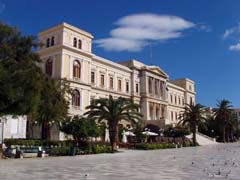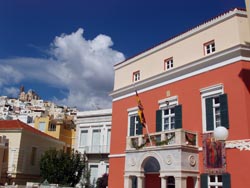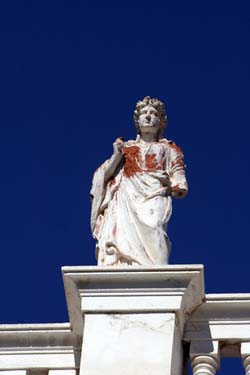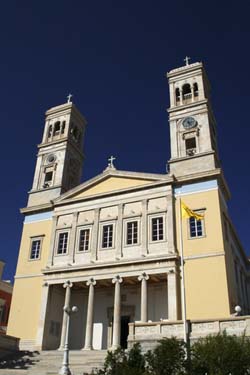You need to upgrade your Flash Player
Please visit Adobe's Flash Player site to upgrade the most recent version.
Thank you.
If you are having issues with installing Adobe Flash Player, please make sure that all "pop-up killer" applications are turned off and you reinstall
the Adobe player.
Syros island

Information about Syros
general information
- Syros belongs to the Cyclades islands cluster
- Capital of Syros is Ermoupolis
- Syros covers around 86 square km
- It has approximately 19,800 inhabitants
- Distance from Piraeus port of Athens is 83 nautical miles
- Distance from Rafina port of Athens is 62 nautical miles
- Connection with Athens International Airport
- Connection with Athens via the ports of Piraeus, Rafina and Lavrio
- Connection with Sifnos, Serifos, Kythnos, Paros, Naxos, Santorini, Folegandros, Ios, Crete and Rhodes

 The northern path of Siros is mountainous and the island stands out in general for the variety of the landscape in its hinterland, where hills alternate with low-lying farming areas. The coastline is indented with inlets of all sizes between capes. There are two large bays, of Ermoupoli to the east and Finikas to the west.
The northern path of Siros is mountainous and the island stands out in general for the variety of the landscape in its hinterland, where hills alternate with low-lying farming areas. The coastline is indented with inlets of all sizes between capes. There are two large bays, of Ermoupoli to the east and Finikas to the west. Archaeological excavations have shown that Syros was inhabited in Neolithic times.
Excavations at Kastri and Halandriani have revealed a prehistoric acropolis, a settlement and a burial ground and yielded artefacts of the Early Cycladic period.
 Syros - Ermoupolis
Syros - Ermoupolis Ermoupolis, "Queen of the Cyclades", is the capital and main harbour of Syros. It is also without doubt the capital of all the Cyclades. Ermoupolis stands on a naturally amphitheatrical site, with neo-classical buildings, old mansions and white houses in the island style cascading down to the harbour. The centre of the town, where Miaouli Square stands ringed with cafes, has a grandeur all its own.
Among the most important buildings are the Town Hall (to plans by Ziller) and the Apollo Municipal Theatre, which is a copy in miniature of La Scala, Milan. There is also a statue of Admiral Miaoulis.
Ermoupolis has a numerous magnificent churches, the most interesting of which are those dedicated to the Transfiguration, the Dormition of Our Lady, St. Demetrius, the Three Hierarchs, and St. Nicolas. The Archaeological Museum has a collection of notable finds, and the Municipal Library contains numerous interesting and rare editions. The quarter of the town known as Vaporia, where the sea-captains lived, is of special interest. Along its narrow streets stand neo-classical mansions. Ano Syros ( Upper Syros ), with its walls, narrow lanes and arches, has kept much of its medieval character. The steep streets and countless steps lend the town the charm of a bygone age.
 At the very top of the town is the Catholic Cathedral of St. George, next to which stands the Centre for Historical Studies. Not far below are the monasteries of the Jesuits and Capoutcins. In the centre of the town is the Town Hall, with the Historical Archives of the Municipality of Ano Syros, and the Museum devoted to the popular composer Markos Vamvakaris, revered as one of the masters of Greek music. Various folklore events take place in Ano Syros, generally during the summer.
At the very top of the town is the Catholic Cathedral of St. George, next to which stands the Centre for Historical Studies. Not far below are the monasteries of the Jesuits and Capoutcins. In the centre of the town is the Town Hall, with the Historical Archives of the Municipality of Ano Syros, and the Museum devoted to the popular composer Markos Vamvakaris, revered as one of the masters of Greek music. Various folklore events take place in Ano Syros, generally during the summer. On the north-east side of the island are Halandriani and Kastri hill, where important prehistoric finds have been made.
The beaches of north-west Syros are difficult to reach. Among places of interest here is Gramata, where inscriptions dating from the Roman and Byzantine periods are to be found carved on the rocks.
The southern and western parts of Syros are the most densely-inhabited. The best beaches are also here, including Galissas, a fine, large resort with a long sandy beach; Possidonia or Delagratsia, a coastal area with a good beach at Angathopes and neo-classical houses of great architectural interest; Vari, with an attractive beach, Finikas bay, Kini and Megas Gialos.
There are more good swimming beaches at Kimata, Agios Nicolaos, Ermoupoli, Ambela, Delfini and Ahladi.
Syros is well-supplied with tourist amenities and its natural beauties and interesting monuments make it an ideal holiday destination. The ease of availability of products and services give the island an advantage over its more isolated neighbours.
Travel in Cyclades
- Cyclades islands
- All Cyclades islands
- Amorgos island
- Anafi island
- Andros island
- Antiparos island
- Delos island
- Donoussa island
- Folegandros island
- Heraklia island
- Ios island
- Kea (Tzia) island
- Keros island
- Kimolos island
- Koufonissia islands
- Kythnos island
- Milos island
- Mykonos island
- Naxos island
- Paros island
- Santorini island
- Schinoussa island
- Serifos island
- Sifnos island
- Sikinos island
- Syros island
- Tinos island

